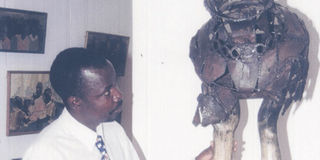Good old Gallery Watatu in limbo

PHOTO | FILE Gallery Watatu was the first CBD gallery to feature both international and local artists.
Gallery Watatu wasn’t the first contemporary art shop to open in Nairobi’s Central Business District (CBD) in the 1960s. There was Paa ya Paa, which opened on Koinange Street in 1965, as founded by six art lovers.
They included Oxford University Press editor Charles Lewis, and Terry Hirst. The latter had been sent by the British Council to start an Art School at what was then Kenyatta College.
Then there were Kenyan art lovers like Jonathan Kariara, James Kangwana, Hilary Ng’weno and the Tanzanian art professor, Elimo Njau. Mr Njau remains the Art Centre director to this day.
Studio 68, which was run by a South African Sherri Hunt, was also there as was the New Stanley Art Gallery right inside the hotel.
But Gallery Watatu was the first CBD gallery to feature both international and local artists. Founded in 1969 by two artists and one graphic designer, its strategic location, halfway between the New Stanley and the Hilton Hotel, meant that from the beginning, it was frequented by global tourists as well as local enthusiasts.
Contrary to the common misconception about the art gallery that it was essentially an expatriate enclave which only exhibited art by whites, one of the three co-founders, Yony Waite, recalls how from early on, the gallery exhibited artworks by Africans like the late Louis Mwaniki, Asians like Usam Ghadan, and Semitic painters from around the Middle East.
Paa ya Paa also attracted an eclectic assortment of mainly African painters. And in its heyday, it also attracted pan-African poets, dancers, musicians, comedians and celebrities like Harry Belafonte, Dick Gregory, and Alvin Ailey.
What made Gallery Watatu distinctive was that the two passionate professional painters, the late Robin Anderson and Yony Waite (who was then known as Jony), simply wanted space to show their own art.
Both women were prolific and also impatient at having to wait in line for exhibition space at the New Stanley, where the two actually first met.
“So we agreed the only alternative was to start a gallery of our own,” recalls Waite, who admits that she and Anderson where very different.
Waite was something of a ‘hippie’ who studied fine art at the University of California at Berkeley and in Japan. Anderson came from a conservative colonial background. But the two women shared a passion for painting. It transcended their differences.
The gallery quickly attracted art lovers from all over the world, many of whom admired the art of Anderson, who painted elegant wildlife scenes on silk batik.
Waite also painted Kenyan wildlife, and only in oils on mainly canvas. The women, together with David Hart to make it three people (watatu, in Kiswahili), readily opened up their space to visiting artists from everywhere.
Contrary to the oft repeated myth that Gallery Watatu only began exhibiting African artists after the German American curator Ruth Schaffner bought it from Waite in 1985 (Anderson had sold out her shares by then), the gallery didn’t discriminate except in terms of the quality of art.
Thus, a number of Makerere-trained artists had major exhibitions at the gallery, including Frances Naggenda (who actually headed Makerere’s art school), Eli Kyeyune and Teresa Musoke. There was also Jak Katarikawe, who technically didn’t study at Makerere, but was mentored by its art professor Sam Ntiru.
Among Kenyans, the Italy-trained sculptor Louis Mwaniki was the first to exhibit at the gallery. Then came Ancent Soi, whose art Yony initially saw at the Nairobi City Market in Soi’s converted vegetable stall.
Sane Wadu and Etale Sukuro were also among the first Kenyans to exhibit at Gallery Watatu in those ‘early days’. Africans from elsewhere who exhibited at the gallery included Jonathan Kingdon from Tanzania and Charles Sekano from South Africa.
What changed when Ruth Schaffner took over the gallery in 1985 was a more intense focus on cultivating contemporary Kenyan art.
She would run workshops for fledgling painters like Shine Tani, who currently runs the Banana Hill Art Gallery.
She also provided aspiring local artists with paints, brushes and papers that they would use to create art, which they would then sell back to Ruth for a few hundred shillings.
Ruth was also a brilliant businesswoman and marketer of Kenyan art. After she died in 1986, the gallery sadly went downhill.
Run for a time by her late husband, the Ivorian businessman Adama Diawara and finally by the Ghanaian journalist Osei Kofi, the status of the gallery is currently in limbo as it had to move out of Lonrho House.
What remains of the gallery’s collection, including unpaid-for art, now sit in the Ongata Rongai Police Station awaiting Kofi’s return from a fundraising mission abroad.




